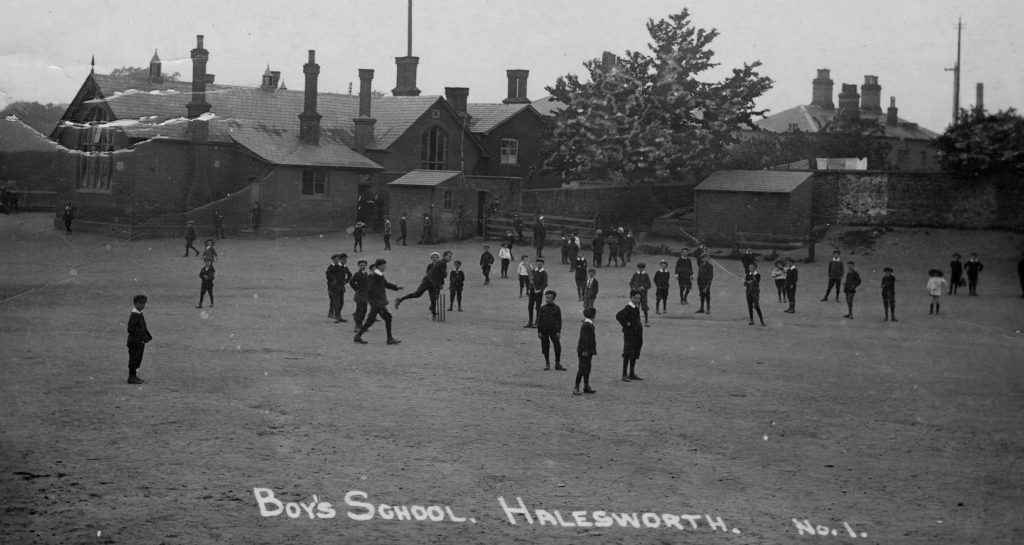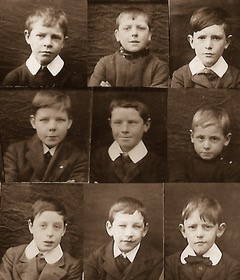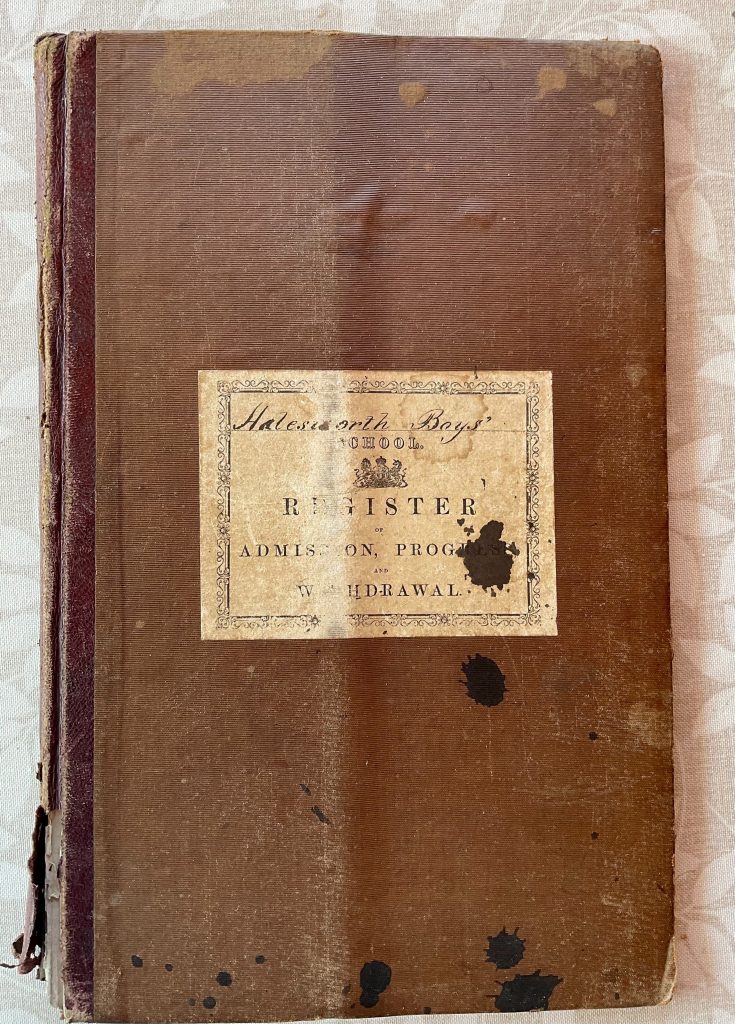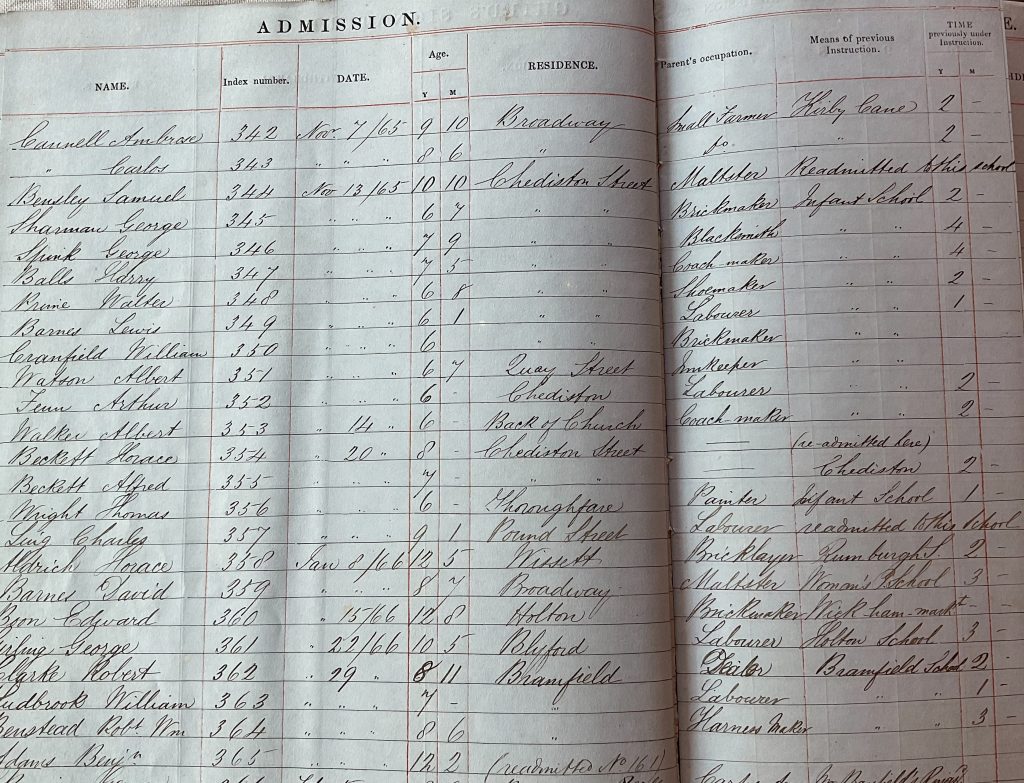A Study of their lives
The Halesworth Museum has within its archive a collection of School Admissions Books, the oldest being one from Halesworth Boys School, which was then situated in Holton Road in what is now three bungalows to the left of the Fire Station when facing it. According to White’s Directory 1855 the school was rebuilt in 1854 at a cost of £550.00 to accommodate 120 scholars.
The ledger lists the names of 849 boys together with some of their personal details from the 7th March 1859 to 19th July 1875 – covering a period of just over 16 years. Skimming through the pages one can see boys from between the age of 6 to 13 were accepted into the school. The boys came from not only Halesworth but the surrounding villages of Holton, Walpole, Wenhaston, Bramfield, Blyford, Cookley, Spexhall, Wissett, Chediston, Westhall, Linstead, Sotherton and St Lawrence. This must have been quite a journey for some, particularly during the winter months.

Whilst occasionally using the book for research purposes I have often wondered what happened to all those boys – where their life journeys had led them. As the Museum was shut for several months earlier this year, I felt it the ideal opportunity to research the lives of these boys, to discover what forms of employment they had taken, where they had spent their adult life and what social patterns could be drawn from such a study.
I decided, if this study should prove to be meaningful I would need to research a substantial number of the boys. Of the 849 entries in the ledger I focused on 240 from the front of the book and 240 working from the back. Of the 480, 323 proved to be researchable. The ledger listed each boy’s name, date and age on admission, address at that time, father’s occupation and any previous educational institutions attended, all of which proved very helpful when searching through birth, death, marriage certificates and census returns.
I traced the boys forward through the census records to ascertain their main occupations throughout their working lives and where they had eventually settled. Before considering this data I feel it is important to consider several points. Firstly, of the original 480 boys, 60% lived in Halesworth when they started their schooling and the remaining 40% came from the surrounding villages. Secondly, the father’s occupation listed suggested that these boys came from mainly working-class families – labouring workers or artisans of various kinds – blacksmiths, shoemakers, carriage builders, tailors, carpenters etc. It is also worthy of mention that Halesworth in the 1870s was quite a prosperous country town with two breweries, four maltings, carriage works, print works, an Iron foundry, gasworks etc. Of course, one should also factor in the expanding rail system which offered possibilities not only in employment but a future beyond Suffolk, to London and further to the youth of the 1870s and ‘80s.
In order to track the boys’ movements to their ultimate place of settlement, I created six groups of boys based upon the distance they travelled from Halesworth – the figure shown is the percentage of the boys I was able to research successfully.
| Halesworth and the surrounding area | 28% |
| Up to 30 miles away | 20% |
| Total | 48% |
| 31 – 90 miles away | 10% |
| London and surrounding area | 23% |
| Further in the UK | 16% |
| Abroad | 3% |
| Total | 52% |
Combining the first two groups we can see 48% remained within 30 miles whilst the rest, 52%, found employment and ultimately settled further afield. Not unsurprisingly London, with 23% proved popular and convenient with the burgeoning rail system, particularly East London and its growing suburbs of East Ham, West Ham, Wandsworth, for example, where 21 of the boys settled. 14 chose South London, 12 – West London and 11 – North London and the remaining 8 in Central London.
Of the boys who moved further afield, interestingly, the industrial areas of the north attracted the largest number of boys – 16, with the home counties second with 13. Of the nine boys left the UK, four went to Australia, three to Canada, one to America and one to work as a missionary in India.
When analyzing the boys’ occupations, I felt it significant to consider where they lived when they began their schooling and how their fathers’ earned their livings. Often individuals would change their employment sometimes quite dramatically but for the purpose of this study, in these instances, I have made a judgement on their main occupation. Not unsurprisingly Agriculture claimed the greatest number of boys – 31 in various forms (Agricultural Labourer, Cattleman, Farm Bailiff, Farmers and Horseman on farm). Of those 31 boys – 29 were resident outside Halesworth in the surrounding villages whilst at school, with just two who lived in Halesworth. My study showed of the 136 researchable boys living in the surrounding villages 29 went into Agriculture – 21%.
Transportation seems to have been the next biggest draw with 13 boys employed by the Railway in various forms and 12 in the Coach and growing Car making industry. Other popular trades and professions included Shoemaking (11), General Labouring (11), Gardening (9), Tailoring (7), Fishing (7), Carpentry (5), the pub industry (5) a military career (5). The school would have been proud to know that three of the boys went on to teach. The data also showed that of the 323 researchable boys, 75 followed their father’s profession (23%).
Of the boys attracted to employment in local towns, 19 moved to Lowestoft, 5 working as fishermen, the rest in a variety of occupations – Insurance Agent, Coach Body maker, Bricklayer, Furness Worker, Draper’s Assistant etc. 12 boys found work in Ipswich, 8 in Norwich, 7 in Beccles etc.
With the aid of census returns and death records I was able to gain some insight into the boys’ life span. Of the 323 researchable boys I was able to ascertain death records for 85%. 25 died before the age of 30, 46 between 31 and 50, 87 between 51 and 70, however 117 of the boys lived beyond 71.
This study has been both interesting and rewarding to work on. I feel it illustrates how much geographical movement there was amongst the working classes in the late 19th/early 20th century and the variety of work they under-took. However, Census returns, birth, death and marriage certificates cannot tell us why these boys made the life decisions they did. For some family tradition played a significant part, as did personal recommend-ations and newspaper advertisements – others would have simply taken their chance and headed out of Halesworth. During my research I came across two boys who were separated on the ledger sheet by just seven boys. They were both age 10 when they were admitted to Holton Road School – Laban Barber from Wenhaston and William Burrell from Walpole. Interestingly, I found Laban on the 1901 census working as a gardener in Kingston-upon-Thames and William was entered on the 1911 census as a Turf Accountant also in Kingston-upon-Thames. I felt this a good indication that some boys did keep in touch with each other after they left school, made recommendations and indeed acted upon them.
I hope this modest study illustrates just how much information can be gained from one primary source and how it is possible to build our knowledge of those who lived their lives during the late 19th to early 20th century.
Alison Whale
Statistics
Most Popular Professions (2 or more)
- 20 Agricultural Labourer
- 13 Railway worker – various occupations
- 12 Coachmaker – various occupations
- 11 Shoemaker
- 11 General Labourer
- 9 Gardener
- 7 Tailor
- 7 Fisherman
- 6 Farmer
- 5 Carpenter
- 5 Licensed Victualer
- 5 Military Career
- 4 Servant
- 4 Painter
- 4 Leather Industry
- 4 Coal Merchant
- 4 Butcher
- 4 Blacksmith
- 3 Baker
- 3 Bricklayer
- 3 Cooper
- 3 Drapery Trade
- 3 Fish Merchant
- 3 Ostler
- 3 Postman
- 3 School Master
- 3 Wheelwright
- 3 Maltster
- 2 Warehouseman
- 2 Sweep
- 2 Stonemason
- 2 Police Constable
- 2 Insurance Agent
- 2 Gun Maker
- 2 Groom
- 2 Grocer
- 2 Farm Bailiff
- 2 Engineer
- 2 Dockworker
- 2 Cook
- 2 Cabinet Maker
- 2 Butler
- 2 Builder



